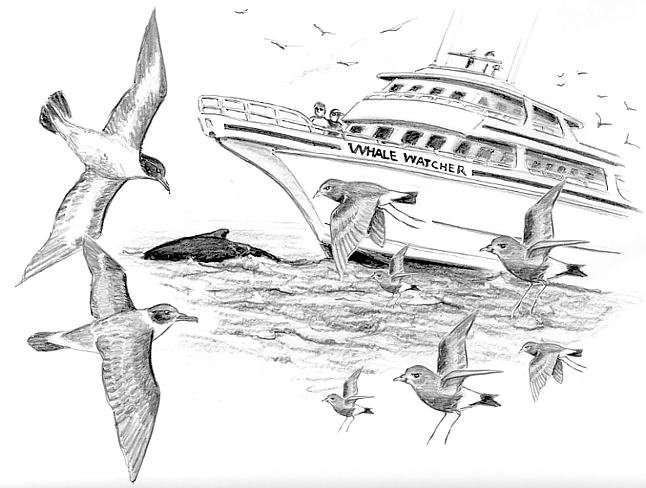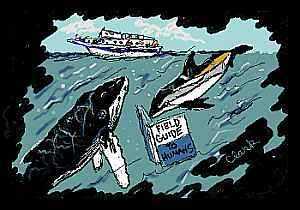
Dear Bird Folks,
Ever since my job was outsourced, I’ve been home listening to a lot of talk radio. Today, for some reason, the topic of the day was whether there were birds out in the middle of the ocean. A merchant mariner called and said that he had seen lots of birds hundreds of miles from land. My bird book mentions albatrosses (albatrossis?), as well as petrels, shearwaters and jaegers, being found out to sea. My question is, if they live way out in the ocean, where do they nest and raise their young-uns?
-Michael, Hudson, MA
Hey Mikey,
I really like your name. Only people of great stature, and me, are given that name. I’m sorry to hear that your job was outsourced. I have no idea what you did for a living, but with a name like Michael I’m sure you were the best. Why is it the people who do the best work always seem to be out of work, while the ones who are the most incompetent somehow end up with jobs of great importance? Funny how that works.
The merchant marine was right, millions of birds can be found out in the middle of the ocean. As strange as it may seem not all birds live in a tree, build cozy nests and eat bird seed. If there is an available food source anywhere in the world birds will figure out a way to take advantage of it. The group of birds that you listed: albatrosses, petrels, shearwaters and jaegers, are birds that have found a way to live and feed on the food found far from land, in the middle of the world’s oceans. By the way, you were correct, it is “albatrosses,” not “albatrossi.” I believe albatrossi is the name of a rash that sailors sometimes get.
Birds that spend the bulk of their life far out to sea are called “pelagic” birds. Although extremely common, pelagic birds were rarely seen by the average bird watcher. Only the hardcore birders, who were brave or foolish enough to venture out on research vessels or sketchy fishing boats, were able to see them. In recent years whale watching trips have allowed us landlubbers to experience the wonders of pelagic birds first hand. Attracted to some of the same food that the whales eat, pelagic birds are often seen on whale watching trips. These seabirds fly just above the surface of the water scooping up small fish, plankton and the recycled breakfast of seasick whale watchers.
What is interesting about many of the pelagic birds is that they migrate to the Northern hemisphere during our summer, just like many land birds do. But unlike the land birds which fly north to breed, these pelagic birds have already finished breeding. They migrate north to escape their winter. Confused? If you turn your radio down for a minute, Mike, I’ll explain.
One of the most common pelagic birds to visit our offshore waters, and one of the most abundant birds in the world, is the Wilson’s Storm-Petrel. About the size of a Purple Martin, Wilson’s Storm-Petrels, as well as many other pelagic birds, breed by the millions on the isolated islands off southern South America and Antarctica. They nest in rock crevices or in burrows, where the female lays a single egg and only moves in and out of the burrow at night in order to avoid avian predators. Even though they nest during the Antarctic summer, December through March, it’s not summer as we know it. There is no need for ceiling fans, central air conditioning or mint juleps in the Antarctic summer. Summer down there can be bitter and nasty. Surprise snow storms may trap young storm-petrels in their burrows with no way out. Apparently the kids next door won’t come over to shovel them out either.
By early fall, which is April, the young storm-petrels are strong enough to fly and they quickly get out of town before the unforgiving Antarctic winter arrives with all of its unpleasantness. The storm-petrels slowly work their way north. By June they can be found enjoying our summer weather and hanging around waiting for the whale watching boats to bring them recycled breakfast.
For the most part the pelagic birds that you referred to nest and raise their “young-uns” on small islands in the Southern hemisphere, but you don’t have to go to Antarctica to find breeding pelagic birds. Our colorful pal, the Atlantic Puffin, is pelagic, a seabird that spends most of its life far out in the ocean, only coming to land to breed. Since you seem to have extra time on your hands right now, Mike, you might want to take trip to coastal Maine to see them. But you had better go soon. The way it’s going, it’s only a matter of time before even the egg laying duties of our seabirds will be outsourced